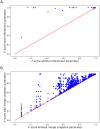A multi-objective based clustering for inferring BCR clonal lineages from high-throughput B cell repertoire data
- PMID: 36037250
- PMCID: PMC9462827
- DOI: 10.1371/journal.pcbi.1010411
A multi-objective based clustering for inferring BCR clonal lineages from high-throughput B cell repertoire data
Abstract
The adaptive B cell response is driven by the expansion, somatic hypermutation, and selection of B cell clonal lineages. A high number of clonal lineages in a B cell population indicates a highly diverse repertoire, while clonal size distribution and sequence diversity reflect antigen selective pressure. Identifying clonal lineages is fundamental to many repertoire studies, including repertoire comparisons, clonal tracking, and statistical analysis. Several methods have been developed to group sequences from high-throughput B cell repertoire data. Current methods use clustering algorithms to group clonally-related sequences based on their similarities or distances. Such approaches create groups by optimizing a single objective that typically minimizes intra-clonal distances. However, optimizing several objective functions can be advantageous and boost the algorithm convergence rate. Here we propose MobiLLe, a new method based on multi-objective clustering. Our approach requires V(D)J annotations to obtain the initial groups and iteratively applies two objective functions that optimize cohesion and separation within clonal lineages simultaneously. We show that our method greatly improves clonal lineage grouping on simulated benchmarks with varied mutation rates compared to other tools. When applied to experimental repertoires generated from high-throughput sequencing, its clustering results are comparable to the most performing tools and can reproduce the results of previous publications. The method based on multi-objective clustering can accurately identify clonally-related antibody sequences and presents the lowest running time among state-of-art tools. All these features constitute an attractive option for repertoire analysis, particularly in the clinical context. MobiLLe can potentially help unravel the mechanisms involved in developing and evolving B cell malignancies.
Conflict of interest statement
The authors have declared that no competing interests exist.
Figures













Similar articles
-
Fast clonal family inference from large-scale B cell repertoire sequencing data.Cell Rep Methods. 2023 Oct 23;3(10):100601. doi: 10.1016/j.crmeth.2023.100601. Epub 2023 Oct 2. Cell Rep Methods. 2023. PMID: 37788671 Free PMC article.
-
Somatic hypermutation analysis for improved identification of B cell clonal families from next-generation sequencing data.PLoS Comput Biol. 2020 Jun 23;16(6):e1007977. doi: 10.1371/journal.pcbi.1007977. eCollection 2020 Jun. PLoS Comput Biol. 2020. PMID: 32574157 Free PMC article.
-
A spectral clustering-based method for identifying clones from high-throughput B cell repertoire sequencing data.Bioinformatics. 2018 Jul 1;34(13):i341-i349. doi: 10.1093/bioinformatics/bty235. Bioinformatics. 2018. PMID: 29949968 Free PMC article.
-
How repertoire data are changing antibody science.J Biol Chem. 2020 Jul 17;295(29):9823-9837. doi: 10.1074/jbc.REV120.010181. Epub 2020 May 14. J Biol Chem. 2020. PMID: 32409582 Free PMC article. Review.
-
The analysis of clonal expansions in normal and autoimmune B cell repertoires.Philos Trans R Soc Lond B Biol Sci. 2015 Sep 5;370(1676):20140239. doi: 10.1098/rstb.2014.0239. Philos Trans R Soc Lond B Biol Sci. 2015. PMID: 26194753 Free PMC article. Review.
Cited by
-
Systematic evaluation of B-cell clonal family inference approaches.BMC Immunol. 2024 Feb 8;25(1):13. doi: 10.1186/s12865-024-00600-8. BMC Immunol. 2024. PMID: 38331731 Free PMC article.
-
ViCloD, an interactive web tool for visualizing B cell repertoires and analyzing intraclonal diversities: application to human B-cell tumors.NAR Genom Bioinform. 2023 Jun 28;5(2):lqad064. doi: 10.1093/nargab/lqad064. eCollection 2023 Jun. NAR Genom Bioinform. 2023. PMID: 37388820 Free PMC article.
-
Fast clonal family inference from large-scale B cell repertoire sequencing data.Cell Rep Methods. 2023 Oct 23;3(10):100601. doi: 10.1016/j.crmeth.2023.100601. Epub 2023 Oct 2. Cell Rep Methods. 2023. PMID: 37788671 Free PMC article.
-
Protocol for fast clonal family inference and analysis from large-scale B cell receptor repertoire sequencing data.STAR Protoc. 2024 Jun 21;5(2):102969. doi: 10.1016/j.xpro.2024.102969. Epub 2024 Mar 18. STAR Protoc. 2024. PMID: 38502687 Free PMC article.
-
Inference of B cell clonal families using heavy/light chain pairing information.PLoS Comput Biol. 2022 Nov 28;18(11):e1010723. doi: 10.1371/journal.pcbi.1010723. eCollection 2022 Nov. PLoS Comput Biol. 2022. PMID: 36441808 Free PMC article.
References
Publication types
MeSH terms
Substances
LinkOut - more resources
Full Text Sources

